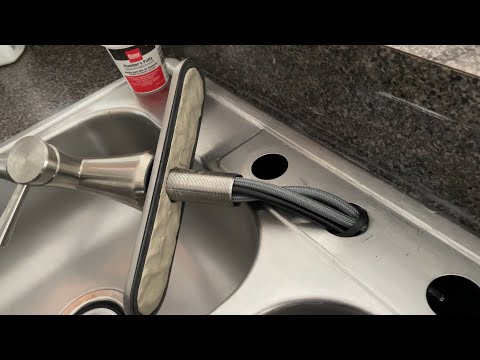Installing a new kitchen sink faucet can seem like a daunting task, especially when you’re faced with a collection of parts and unfamiliar instructions. One common question that arises during this process is whether or not plumber’s putty is necessary. Understanding the purpose of plumber’s putty and where it’s appropriately used is crucial for a successful and leak-free installation. This guide will explore when and where plumber’s putty is needed, alternative options, and best practices for ensuring a watertight seal.
Understanding Plumber’s Putty
Plumber’s putty is a pliable, clay-like substance used to create watertight seals around plumbing fixtures. It’s designed to remain flexible and prevent water from seeping through gaps. However, it’s important to understand that plumber’s putty isn’t a universal solution for all plumbing connections.
When to Use Plumber’s Putty
Plumber’s putty is typically used in the following situations:
- Sealing the Sink Flange: This is perhaps the most common application. Plumber’s putty creates a seal between the sink flange (the part that connects the drain to the sink) and the sink basin itself.
- Sealing Strainer Baskets: Similar to the sink flange, putty helps seal the strainer basket to the sink, preventing leaks around the drain opening.
- Around Faucet Bases (Sometimes): If the faucet base doesn’t have a rubber gasket, plumber’s putty can be used to seal the faucet base to the countertop. However, many modern faucets come with integrated gaskets.
When to Avoid Plumber’s Putty
There are situations where using plumber’s putty is not recommended or even detrimental:
- Pressurized Water Lines: Plumber’s putty is not designed for pressurized water lines. Use Teflon tape or pipe dope (pipe joint compound) for threaded connections on water supply lines.
- Plastic Fittings: Some plumbers advise against using plumber’s putty on plastic fittings, as the oils in the putty can potentially degrade certain plastics over time. Check the manufacturer’s recommendations.
- Rubber Gaskets: If a faucet or fitting already has a rubber gasket, adding plumber’s putty is usually unnecessary and can even prevent the gasket from seating properly.
Alternatives to Plumber’s Putty
While plumber’s putty is a traditional choice, several alternatives offer different benefits:
- Silicone Caulk: Silicone caulk provides a more permanent and waterproof seal compared to plumber’s putty. However, it’s less forgiving and can be more difficult to remove if needed.
- Rubber Gaskets: Many modern faucets and fixtures come with rubber gaskets designed to create a watertight seal. These are often preferred for their ease of installation and reliability.
- Pipe Dope (Pipe Joint Compound): Used for threaded pipe connections, pipe dope creates a seal and lubricates the threads, making it easier to tighten the connection.
- Teflon Tape (Thread Seal Tape): Similar to pipe dope, Teflon tape is used on threaded connections to create a watertight seal.
Best Practices for Using Plumber’s Putty
If you decide to use plumber’s putty, follow these best practices:
- Clean the Surfaces: Ensure the surfaces you’re applying the putty to are clean and dry.
- Knead the Putty: Knead the putty in your hands until it’s soft and pliable.
- Apply Evenly: Apply a uniform rope of putty around the area to be sealed.
- Press Firmly: Press the fixture firmly into the putty to create a good seal.
- Remove Excess: Remove any excess putty with a putty knife or your finger.
Factoid: Plumber’s putty doesn’t “dry” like caulk. It remains pliable, allowing for slight movement without breaking the seal. This is beneficial in areas prone to vibration or temperature changes.
FAQ: Plumber’s Putty and Kitchen Sink Faucets
Q: Can I use plumber’s putty on the water supply lines of my kitchen faucet?
A: No. Plumber’s putty is not designed for pressurized water lines. Use Teflon tape or pipe dope for these connections.
Q: My new faucet came with a rubber gasket. Do I still need plumber’s putty?
A: Generally, no. If your faucet has a rubber gasket, it’s designed to create a watertight seal on its own. Adding plumber’s putty may actually hinder the gasket’s performance.
Q: How long does plumber’s putty last?
A: Plumber’s putty doesn’t “wear out” in the traditional sense. It remains pliable for many years. However, it can dry out and crack if exposed to air for extended periods. Keep it sealed in its container when not in use.
Q: Is plumber’s putty toxic?
A: Plumber’s putty is generally considered non-toxic, but it’s always a good idea to wash your hands after handling it.
Q: Can I use plumber’s putty to fix a leaky pipe?
A: No. Plumber’s putty is not a permanent fix for leaky pipes. It’s designed to create seals around fixtures, not to patch holes or cracks in pipes. You’ll need a more robust solution, such as pipe repair tape or a replacement pipe section.

